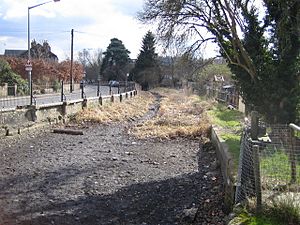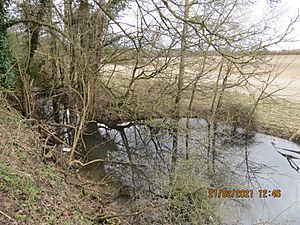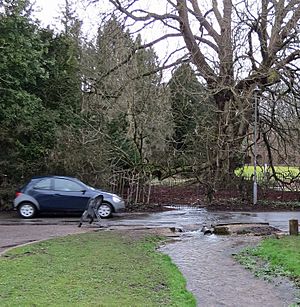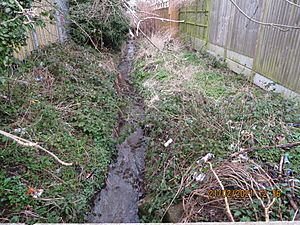River Chess facts for kids
Quick facts for kids Chess |
|
|---|---|
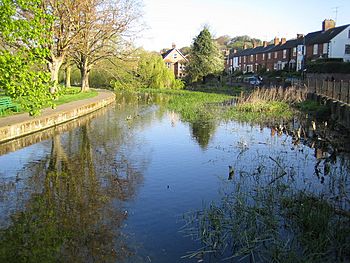
River Chess at Waterside, Chesham
|
|
| Country | England |
| Counties | Buckinghamshire, Hertfordshire |
| Towns/Cities | Chesham, Rickmansworth |
| Physical characteristics | |
| Main source | Chesham Vale, Pednor 112m 51°42′02″N 0°37′44″W / 51.70056°N 0.62889°W |
| River mouth | River Colne at Rickmansworth 48m 51°38′06″N 0°28′0″W / 51.63500°N 0.46667°W |
| Length | 17.9 km (11.1 mi) |
The River Chess is a special kind of river called a chalk stream. It starts near Chesham in the Chiltern Hills and flows for about 11 miles (17.9 km). It travels through two counties, Buckinghamshire and Hertfordshire. Finally, it joins the River Colne in Rickmansworth. The River Chess, along with the Colne and Gade, even gave its name to the local area, the Three Rivers district.
Contents
What's in a Name?
The name of the River Chess actually comes from the town of Chesham. Long ago, it was known by a different name: the Pittlesburne. The word burna was an old term used in the Chilterns. It described a clear stream that was fed by springs and often had a stony bottom. Other rivers like the Misbourne and Bulbourn also have this old word in their names.
The River's Journey
The River Chess drops about 60 meters (197 ft) from its start to its end. It gets its water from underground stores called aquifers in the chalk hills. It begins from three different springs. These springs surface as Vale brook, from Bury Pond, and near Pednor just north of Chesham.
The river flows hidden beneath Chesham town in underground tunnels. Then it flows southeast through an area called Waterside. It passes through beautiful parkland designed by a famous landscape architect, Capability Brown, at Latimer House. You can also find the site of a 1st Century Roman villa near the village of Latimer.
The Chess continues past Chenies and through special water meadows at Frogmore. It also flows by the watercress beds at Sarratt Bottom, west of Sarratt. The river goes under the M25 motorway at Solesbridge Lane. After that, it flows through a private housing area called Loudwater. This area's name is linked to the river itself.
Further along, the river passes several old water mills. These mills used the river's power to make paper in the 1700s and 1800s. Finally, at Rickmansworth, the Chess joins the River Colne. Most of the river banks are not open to the public. Only small parts of the river can be easily reached.
When the River Runs Low
The River Chess has faced serious water shortages, also known as droughts. This happened for about two years between 2004 and 2006, and again in 2011 and 2012. These droughts were caused by much less rainfall than usual for long periods. Winter rain is especially important because it helps refill the underground water stores.
Luckily, heavy rain in April and June 2012 helped the underground water levels slowly rise. This was good news because usually, water levels drop during those months. By July 2012, the River Chess was showing signs of getting better.
During the 2005 drought, some people thought that too much water was being taken from the river for bottling by a company called Nestlé's Powwow Water. After this water extraction stopped, the river started to recover. However, the riverbed had become very overgrown. Volunteers helped clear out the extra plants in 2012, which allowed the river to flow better.
Amazing Wildlife
The Chess Valley is part of the Chiltern Hills Area of Outstanding Natural Beauty (AONB). This means it's a special place for nature! It's home to many important animals and plants found in chalk streams and the Chiltern Hills.
- Mammals: You might spot water voles.
- Birds: Look out for green sandpipers, grey herons, grey wagtails, little egrets, ospreys, mute swans, stonechats, water rails, and kingfishers.
- Plants: The river has beautiful plants like water crowfoot, purple loosestrife, hemp agrimony, water forget-me-nots, and branched bur-reed.
- Fish: In the clear water, you can find brown trout, grayling, and bullhead.
- Insects: To support the fish, there are many different insects and tiny creatures, including the mayfly.
How Humans Have Shaped the Valley
The Chess Valley has been home to people for a very long time. There are sites of Roman villas, like Latimer Park. At Sarratt, you can see old terraces on the hillsides called strip lynchets. These were made by farming long ago and might have been medieval vineyards.
People living in the valley have changed the river and its surroundings in many ways. Not all of these changes have been good for the wildlife. For example, when rivers are made wider or dredged (cleaned out), the water flows slower. This allows mud to build up and cover the stony riverbed, which can harm creatures living there.
Changes in how the land is used also affect the river. Water meadows have been replaced by farms and buildings. This changes how water drains and can cause pollution. Also, taking too much water from the underground chalk aquifer reduces the river's flow. This makes it harder for the river to handle droughts.
Invasive Species
Some new species, called invasive species, have been brought into the river's area. These have had a big impact on the wildlife.
- Mink: The number of water voles in the Chess dropped hugely between 2001 and 2003. This was mainly because of the North American mink. Mink were brought to the UK for their fur, but they escaped and became a problem for native animals. To help the water voles, a project started in 2004 to control mink and improve the voles' habitat. By 2005, the water vole population had started to recover.
- Signal Crayfish: Sadly, the native white-clawed crayfish has suffered because of another American import: the signal crayfish. Signal crayfish were brought in for fish farms. But they are very good at escaping! They quickly spread into rivers across the UK. Signal crayfish carry a disease called crayfish plague. They are not affected by it, but our native white-clawed crayfish are. This has caused the native crayfish to disappear from most UK rivers, including the Chess, where they have been gone since the mid-1990s.
- Invasive Plants: The Chess also has some invasive plants like Japanese knotweed, Himalayan balsam, and Orange balsam.
Not all new species cause big problems. The rainbow trout escaped from fish farms and fisheries into the Chess in the early 1900s. They have now created one of the few self-sustaining populations in the UK.
Water Quality
Some of the water in the Chess comes from treated water released from the Chesham Sewage Treatment Works. This is especially true during dry times. However, when there's very heavy rainfall, untreated water can sometimes flow into the river. In 2014, this happened for five months, which greatly affected the river's water quality. Since then, improvements have been made to the treatment works to handle more water.
Chess Cress: A Local Treat

The clear, chalk stream water of the River Chess, along with the rich soil, was perfect for growing watercress. This industry was very successful in Chesham and Rickmansworth during the Victorian era. The watercress was sent to London on the new Metropolitan Railway. Today, the only working watercress beds are at Moor Lane, Sarratt. In 2014, due to ongoing water quality issues from the Chesham Sewage Treatment Works, the watercress farm had to stop selling its produce. To keep operating, the farm now uses water from a well instead of the river.
Explore the Chess Valley Walk
The Chess Valley Walk is a great way to explore the area! It's about 10 miles (16 km) long. You can start or finish at the Metropolitan line stations in Chesham, Chorleywood, and Rickmansworth. This means you can walk just a part of the route or the whole thing. The path is clearly marked, and you can walk in either direction. Most of the walk is on public footpaths, but there are a few short sections on roads.



